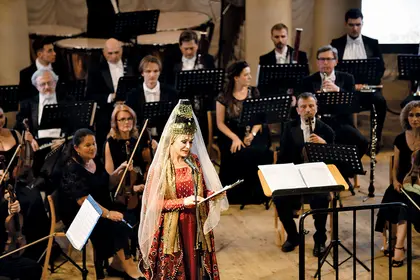A Ukrainian girl is kidnapped from her village at the age of 15, taken as a slave to the Ottoman Empire, but ends up marrying Sultan Suleiman the Magnificent.
The story is 500 years old, and often thought to be no more than a romantic legend, but it still inspires artists, and unites Ukraine and Turkey. The woman, known as Roksolana, was honored at a concert in the National Philharmonic of Ukraine on June 11 organized by the Turkish Embassy and Ukraine’s Culture Ministry.
The concert featured a selection of musical pieces written in different centuries and devoted to the great sultan’s wife. Music by Joseph Haydn, Nevit Kodalli, Dmytry Akimov, Yevhen Stankovych and Aytekin Atas was performed by the Ukrainian Radio Symphony Orchestra, conducted by Volodymyr Sheiko.
“It is so surprising that composers from so many different countries dedicated their artworks to this woman,” Sheiko said.
Ukrainian actress Olha Sumska, who played Roksolana in a Ukrainian TV-series of the same name, read lines from letters said to have been written by Roksolana to her beloved spouse while he was away on a military expedition.
From the 14th to the early 20th century, the Ottoman Empire controlled much of southeastern Europe, western Asia and North Africa. It reached the peak of its power in the 16th and 17th centuries, during the reign of Suleiman the Magnificent.
Sumska believes Roksolana must have been a really astonishing woman, and Yonet Can Tezel, Turkey’s ambassador to Ukraine, agrees.
“We wanted to showcase the heritage that Turkey and Ukraine share,” Tezel said.
“And Roksolana is the perfect figure for this.”
Susanna Chakhoyan, a soloist of National Opera of Ukraine, rated the concert highly.
“It pleases my soul to see official establishments arranging such an entrancing concert.” Chakhoyan said. “Also, I know Tezel family, and there is something intriguing in the fact that they were the ones to organize this concert. You know, I would compare Suleiman’s deep affection for Roksolana to Yonet’s love for (his wife) Ave.”
The concerts attracted attendees from Ukraine, Turkey and other countries.
Anamika Bharti, wife of Manoj Bharti, the Indian ambassador to Ukraine, lived in Turkey for a while, and knows the story of Roksolana well.
“I did like the concert,” Bharti said. “And I think Roksolana’s love story is a fairytale.”
Rise of a slave girl
Despite many novels being written and much research done on Roksolana, known in Turkey as Hurrem Sultan, there is little of factual information about her. Primary sources on Hurrem are her correspondence with Suleiman, the harem salary records, and Suleiman’s diaries.
Samuel Twerdovski, who worked in the Polish Embassy to the Ottoman Empire in 1621 and 1622, and Ukrainian orientalist Ahatanhel Krymsky, claim that her birth name was Nastya Lisovska and that she was the daughter of an Orthodox priest from Rohatyn, a small town near the western city of Lviv. An old song from that region tells a story of a girl who was kidnapped by Tatars, Turkic-speaking people who captured and exported slaves to Ottaman Empire. Lisovska was enslaved and sold into the sultan’s harem.
Turkish archives say that she probably entered the harem between 1517–1520, when she was around 15. Suleiman was around 25 when he met his wife-to-be.
Some sources say that Roksolana was born in 1503. This theory is also supported by Suleiman’s marriage certificate, which states that his wife was 11 years younger than he was. Suleiman was born in 1492.
Not long after Roksolana and Suleiman met, she ousted Gulbenar (in other sources — Mahidevran), the mother of Suleiman’s first-born son, from the position of favorite concubine. Roksolana became the one and only woman in the sultan’s heart, as Suleiman’s love letters and poems to his spouse prove.
To be with Hurrem, Suleiman had to violate many rules. First of all, in 1533 or 1534 he married Hurrem, violating the custom according to which sultans were not to marry their concubines.
The sultan also violated another law: While having a harem with thousands of women in it, he is believed to having become practically monogamous, which was unprecedented in Ottoman history.
Based on information from her personal letters, Roksolana was mother to six children (although sources widely disagree on how many children she had) and this was another violation of the old royal principle. Historically, to prevent a mother having too much influence over the sultan, a concubine was allowed to have only one son.
Throughout the ages, many theories spread to account for Roksolana’s influence on Suleiman: her beauty, her joyous spirit, her political genius, and her cleverness.
Many sources, including Venetian reports, claim she wasn’t particularly beautiful, but rather small and graceful, and that she laughed a lot.
Her joyous approach to life found reflection even in her name, Hurrem, which means “joyful” or “laughing one.” Roksolana was a nickname given by European observers and historians who were referring to the province of Ruthenia in western Ukraine where she was allegedly born.
What is known for sure is that Hurrem reduced the number of Tatar raids on Polish lands. Piotr Opalinski, the Polish ambassador to Suleiman’s court in 1533, confirmed that through Roksolana’s pleading, the sultan forbade the Tatars to raid the part of Ukraine then under Polish control — the lands from which the sultan’s wife had been kidnapped, many years before.
You can also highlight the text and press Ctrl + Enter







Comments (0)